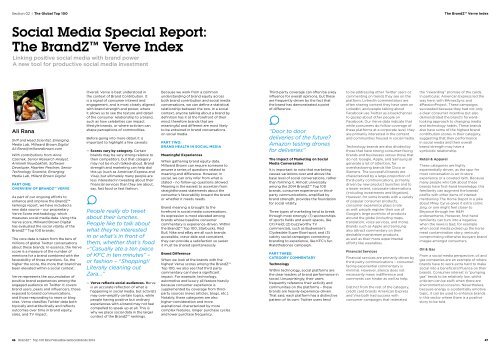download-report
download-report
download-report
Create successful ePaper yourself
Turn your PDF publications into a flip-book with our unique Google optimized e-Paper software.
Section 02 | The Global Top 100<br />
The BrandZ Verve Index<br />
Social Media Special Report:<br />
The BrandZ Verve Index<br />
Linking positive social media with brand power<br />
A new tool for productive social media investment<br />
Ali Rana<br />
SVP and Head Scientist, Emerging<br />
Media Lab, Millward Brown Digital<br />
Ali.Rana@millwardbrown.com<br />
With contributions from Anne<br />
Czernek, Senior Research Analyst,<br />
Armineh Nourbakhsh, Software<br />
Developer, Maarten Peschier, Senior<br />
Technology Scientist, Emerging<br />
Media Lab, Millard Brown Digital<br />
PART ONE:<br />
OVERVIEW OF BRANDZ VERVE<br />
As part of our ongoing efforts to<br />
enhance and improve the BrandZ<br />
rankings <strong>report</strong>, we have included a<br />
new data source – our proprietary<br />
Verve Score methodology, which<br />
measures social media data. Using this<br />
Verve score, Millward Brown Digital<br />
has evaluated the social vitality of the<br />
BrandZ Top 100 brands.<br />
The core data is taken from the tens of<br />
millions of global Twitter conversations<br />
about these brands. In essence, the Verve<br />
score is a measure of the number of<br />
mentions for a brand combined with the<br />
favorability of those mentions. So, the<br />
higher the score, the more that brand has<br />
been elevated within a social context.<br />
Verve represents the accumulation of<br />
positive brand experiences among the<br />
engaged audience on Twitter. It covers<br />
brand users, peers and influencers, those<br />
exposed to brand communications,<br />
and those responding to news or blog<br />
sites. Verve classifies Twitter data both<br />
topically and attitudinally and reflects<br />
outcomes over time in brand equity,<br />
sales, and TV impact.<br />
Overall, Verve is best understood in<br />
the context of Brand Contribution. It<br />
is a signal of consumer interest and<br />
engagement, and is most closely aligned<br />
with brand strength and power, where<br />
it allows us to see the texture and detail<br />
of the consumer relationship to a brand,<br />
such as how celebrities can impact<br />
lifestyle brands, or where activism can<br />
shape perceptions of commodities.<br />
Before going into more detail, it is<br />
important to highlight a few caveats:<br />
— Scores vary by category. Certain<br />
brands may be very strong relative to<br />
their competitors, but that category<br />
may not be much talked-about. Brand<br />
strength and marketing can help dial<br />
this up (such as American Express and<br />
Visa), but ultimately many people are<br />
less interested in tweeting about their<br />
financial services than they are about,<br />
say, fast food or fast fashion.<br />
People really do tweet<br />
about their lunches.<br />
People like to talk about<br />
what they’re interested<br />
in or what’s in front of<br />
them, whether that’s food<br />
–“Casually ate a ten piece<br />
of KFC in ten minutes” –<br />
or fashion – “Shopping!!<br />
Literally cleaning out<br />
Zara…”<br />
— Verve reflects social audiences. Verve<br />
is an accurate reflection of what is<br />
happening in social media, but activists<br />
may over-amplify certain topics, while<br />
people having positive but ordinary<br />
experiences with a brand may not feel<br />
compelled to speak up at all. This is<br />
why we place social data in the larger<br />
context of the BrandZ rankings.<br />
Because we work from a common<br />
understanding of brand equity across<br />
both brand contribution and social media<br />
conversations, we can define a statistical<br />
relationship between the two. In a social<br />
context, anyone talking about a brand by<br />
definition has it at the forefront of their<br />
mind; therefore brands that are<br />
meaningful and different are most likely<br />
to be entwined in brand conversations<br />
on social media.<br />
PART TWO:<br />
BRAND HEALTH IN SOCIAL MEDIA<br />
Meaningful Experiences<br />
When gathering brand equity data,<br />
Millward Brown can require someone to<br />
answer a series of questions related to<br />
meaning and difference. However, in<br />
social, we can only infer from what is<br />
stated – no follow-up questions allowed.<br />
Meaning is the easiest to ascertain from<br />
straightforward statements about the<br />
consumer’s favorability toward the brand<br />
or whether it meets needs.<br />
Brand meaning is brought to the<br />
forefront in social media conversations.<br />
Its expression is most elevated among<br />
brands whose baseline consumer<br />
commentary is experience-driven. Within<br />
the BrandZ Top 100, Starbucks, Red<br />
Bull, Nike and eBay are all such brands:<br />
accessible, crave-able and consistent,<br />
they can provide a satisfaction so sweet<br />
it must be shared spontaneously.<br />
Brand Difference<br />
When we look at the brands with the<br />
highest Verve scores among the BrandZ<br />
Top 100, we also see that third party<br />
commentary can have a significant<br />
impact. For example, technology,<br />
automotive and luxury all feature heavily<br />
because consumer experience is<br />
supplemented by coverage from thirdparty<br />
sources (news articles, blogs, etc.).<br />
Notably, these categories are also<br />
higher-consideration and more<br />
aspirational, characterized by more<br />
complex features, longer purchase cycles<br />
and lower purchase frequency.<br />
Third-party coverage can often be a key<br />
influence for overall opinions, but these<br />
are frequently driven by the fact that<br />
the brand has demonstrated a point<br />
of difference.<br />
“Door to door<br />
deliveries of the future?<br />
Amazon testing drones<br />
for deliveries”<br />
The Impact of Marketing on Social<br />
Media Conversation<br />
It is important to note that marketing<br />
causes variations over and above the<br />
base level of social conversations, rather<br />
than forming it. Almost universally<br />
among the 2014 BrandZ Top 100<br />
brands, consumer experience or thirdparty<br />
communications, amplified by<br />
brand strength, provides the foundation<br />
for social vitality.<br />
Three types of marketing tend to break<br />
through most strongly: (1) sponsorships<br />
of sports fields and event spaces, like<br />
Citi Field; (2) buzzworthy TV<br />
commercials, such as Budweiser’s<br />
Clydesdale Super Bowl spot; and (3)<br />
catchy social campaigns connecting<br />
branding to experience, like KFC’s fun<br />
#iatethebones campaign.<br />
PART THREE:<br />
CATEGORY COMMENTARY<br />
Technology<br />
Within technology, social platforms are<br />
the clear leaders of brand performance in<br />
social. Unsurprisingly, their users<br />
frequently reference their activity and<br />
communities on the platforms – these<br />
brands are heavily experience-driven.<br />
That said, each platform has a distinctive<br />
pattern of its own: Twitter users tend<br />
to be addressing other Twitter users or<br />
commenting on trends they see on the<br />
platform; LinkedIn commentators are<br />
often sharing content they have seen on<br />
LinkedIn; and people talking about<br />
Facebook use Twitter as a backchannel<br />
to gossip about other people on<br />
Facebook. Our Verve data indicate that<br />
while consumers do follow coverage of<br />
these platforms at a corporate level, they<br />
are primarily interested in the content<br />
and communities housed in social media.<br />
Technology brands are also divided by<br />
those that have strong consumer-facing<br />
brands and businesses versus those that<br />
do not: Google, Apple, and Samsung all<br />
generate a lot of attention, far<br />
overshadowing brands like Cisco or<br />
Siemens. The successful brands are<br />
characterized by a large proportion of<br />
third-party communications, primarily<br />
driven by new product launches and to<br />
a lesser extent, corporate observations<br />
(including investments and litigation).<br />
However, for some brands with a variety<br />
of popular consumer products,<br />
consumer experience plays a role<br />
as well: people register their use of<br />
Google’s large portfolio of products<br />
around the globe (including maps,<br />
translation, voice services, and more).<br />
Brands such as Apple and Samsung<br />
also attract commentary on their<br />
desirable mainstream products,<br />
as well as their more experimental<br />
efforts like wearables.<br />
Financial Services<br />
Financial services are primarily driven by<br />
third-party communications – consumerfacing<br />
experiential commentary is<br />
minimal. However, silence does not<br />
necessarily mean indifference and<br />
comments can hinder as well as help.<br />
Distinct from the rest of the category,<br />
credit card brands American Express<br />
and Visa both had success with<br />
consumer campaigns that reiterated<br />
the “rewarding” promise of the cards.<br />
In particular, American Express led the<br />
way here, with #AmexSync and<br />
#PassionProject. These campaigns<br />
succeeded because they had not only<br />
a clear consumer incentive but also<br />
demonstrated the brand’s forwardlooking<br />
approach to changing media<br />
and technology habits. These brands<br />
also have some of the highest brand<br />
contribution scores in their category,<br />
suggesting that their performance<br />
in social media and their overall<br />
brand strength may have a<br />
symbiotic relationship.<br />
Retail & Apparel<br />
These categories are highly<br />
experientially driven, as the spur for<br />
most conversation is an in-store<br />
experience or a coveted item. Because<br />
many people who talk about these<br />
brands have first-hand knowledge, this<br />
familiarity can augment the brands’<br />
profile with other items of interest:<br />
mentioning The Home Depot in a joke<br />
about Miley Cyrus gives it extra comic<br />
zing; or one might feel closer to<br />
Beyoncé through her H&M<br />
endorsements. However, first-hand<br />
familiarity can turn into a negative<br />
when the news is bad, for example<br />
when social media picked up the horse<br />
meat contamination story, seriously<br />
compromising otherwise buoyant brand<br />
images amongst consumers.<br />
Oil & Gas<br />
From a social media perspective, oil and<br />
gas companies are an example of where<br />
brands have to work extra hard to make<br />
social into a beneficial influence on their<br />
brands. Consumer interest in “pumping<br />
gas” tends to be relatively low, whilst<br />
criticism can be swift when there are<br />
environmental concerns. Nevertheless,<br />
because energy is a potentially emotive<br />
topic, it can be used to enhance brands<br />
in this sector where there is a positive<br />
story to be told.<br />
46 BrandZ Top 100 Most Valuable Global Brands 2014 47



